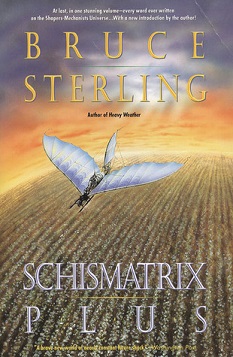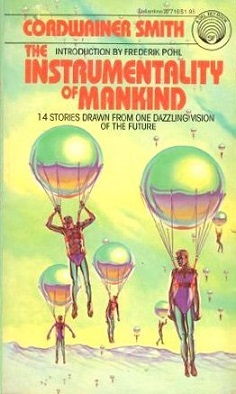I want to read more short science fiction and fantasy, even have subscribed to Clarkesworld and Apex Magazine but the digital issues keep piling up on my virtual coffee table. I need to set myself a challenge, to actually start reading short fiction again.
Enter Monsieur Caution’s nicely curated list of noticable fantasy, horror and science fiction short stories published in 2014. That seems like a nice challenge to plough through. Read one or two a day, jot down some notes about them here, see if I can get through it before the Hugo nominations close.
The list:
- Charlie Jane Anders, “The Unfathomable Sisterhood of Ick.” Lightspeed, June 2014 (“Women Destroy Science Fiction!” special issue); reprinted at Tor.com. [LM]
- Eleanor Arnason, “The Scrivener.” Subterranean, Winter 2014. [JS; LM]
- Dale Bailey, “The End of the End of Everything.” Tor.com, April 23, 2014. [LM; UM]
- Jessica Barber, “Coma Kings.” Lightspeed, February 2014. [GD]
- Elizabeth Bear, “Covenant.” Slate, September 11, 2014. [GD; JS; LM]
- Elizabeth Bear, “This Chance Planet.” Tor.com, October 22, 2014. [FW; LM]
- Helena Bell, “Lovecraft.” Clarkesworld, October 2014. [UM]
- Holly Black, “Ten Rules for Being an Intergalactic Smuggler (the Successful Kind).” Lightspeed, September 2014. [JS; LM]
- Aliette de Bodard, “The Days of the War, as Red as Blood, as Dark as Bile.” Subterranean, Spring 2014. [GD; LM]
- Richard Butner, “Circa.” Interfictions Online #3, May 2014. [UM]
- Richard Bowes, “Sleep Walking Now and Then.” Tor.com, July 9, 2014. [FW; LM; UM]
- Chaz Brenchley, “The Burial of Sir John Mawe at Cassini.” Subterranean, Spring 2014. [GD]
- Siobhan Carroll, “The Year of Silent Birds.” Beneath Ceaseless Skies, January 9, 2014. [FW]
- Dario Ciriello, “Free Verse.” Free Verse and Other Stories, Panverse, 2014. [KL]
- C. S. E. Cooney, “Witch, Beast, Saint: an Erotic Fairy Tale.” Strange Horizons, July 21, 2014. [LM]
- Julio Cortázar, “Headache.” Tor.com, September 3, 2014 (first English translation). [K&K]
- Tom Crosshill, “The Magician and Laplace’s Demon.” Clarkesworld, December 2014. [KL; LM; UM]
- Amanda C. Davis, “Loving Armageddon.” Crossed Genres, July 2, 2014. [K&K]
- Amal El-Mohtar, “The Truth About Owls.” Strange Horizons, January 26, 2015 (originally published in Alisa Krasnostein and Julia Rios (eds.), Kaleidoscope, Twelfth Planet Press, 2014). [JS; LM]
- Ruthanna Emrys, “The Litany of Earth.” Tor.com, May 14, 2014. [LM]
- K. M. Ferebee, “The Earth and Everything Under.” Shimmer #19, 2014. [FW; K&K]
- Jeffrey Ford, “The Prelate’s Commission.” Subterranean, Winter 2014. [LM]
- Karen Joy Fowler, “Nanny Anne and the Christmas Story.” Subterranean, Winter 2014. [K&K; LM]
- Max Gladstone, “A Kiss with Teeth.” Tor.com, October 29, 2014. [TC; previously on MeFi]
- Kathleen Ann Goonan, “A Short History of the Twentieth Century, or, When You Wish Upon A Star.” Tor.com, July 20, 2014. [LM]
- Theodora Goss, “Cimmeria: From the Journal of Imaginary Anthropology.” Lightspeed, July 2014. [JS; LM]
- Nicola Griffith, “Cold Wind.” Tor.com, April 16, 2014. [JS]
- Shane Halbach, “Copy Machine.” Flash Fiction Online, June 2014. [KL]
- Maria Dahvana Headley, “The Tallest Doll in New York City.” Tor.com, February 14, 2014. [FW; LM]
- Kat Howard, “The Saint of the Sidewalks.” Clarkesworld, August 2014. [LM]
- Pasi Ilmari Jääskeläinen, “Where the Trains Turn.” Tor.com, November 19, 2014. [LM]
- N. K. Jemisin, “Stone Hunger.” Clarkesworld, July 2014. [FW]
- Xia Jia, “Spring Festival: Happiness, Anger, Love, Sorrow, Joy.” Translated by Ken Liu. Clarkesworld, September 2014. [KL; UM]
- Xia Jia, “Tongtong’s Summer.” Translated by Ken Liu. Clarkesworld, December 2014 (originally in Neil Clarke (ed.), Upgraded, Wyrm Publishing, 2014). [KL]
- Rachael K. Jones, “Makeisha in Time.” Crossed Genres #20, August 2014. [BC]
- Stephen Graham Jones, “Chapter Six.” Tor.com, June 11, 2014. [LM]
- Vylar Kaftan, “Ink of My Bones, Blood of My Hands.” Beneath Ceaseless Skies, June 12, 2014. [FW]
- Caitlín R. Kiernan, “Bus Fare.” Subterranean, Spring 2014. [K&K]
- Ellen Klages, “Caligo Lane.” Subterranean, Winter 2014. [LM]
- Jay Lake, “West to East.” Subterranean, Summer 2014. [GD; LM]
- Rich Larson, “The Air We Breathe is Stormy, Stormy.” Strange Horizons, August 11, 2014. [K&K]
- Yoon Ha Lee, “Combustion Hour.” Tor.com, June 18, 2014. [FW; LM; UM; previously on MeFi]
- Yoon Ha Lee, “The Contemporary Foxwife.” Clarkesworld, July 2014. [LM; previously on MeFi]
- Yoon Ha Lee, “Wine.” Clarkesworld, January 2014. [LM; previously on MeFi]
- Rose Lemberg, “A City on Its Tentacles.” Lackington’s, Winter 2014. [SS]
- Kelly Link, “I Can See Right Through You.” McSweeney’s Quarterly 48, 2014. [LM]
- Ken Liu, “Reborn.” Tor.com, January 29, 2014. [UM]
- Ken Liu, “The Long Haul, From the ANNALS OF TRANSPORTATION, The Pacific Monthly, May 2009.” Clarkesworld, November 2014. [GD; JS; LM]
- Carmen Maria Machado, “Observations About Eggs from the Man Sitting Next to Me on a Flight from Chicago, Illinois to Cedar Rapids, Iowa.” Lightspeed, April 2014. [K&K; SS]
- Carmen Maria Machado, “The Husband Stitch.” Granta, October 28, 2014. [K&K; UM; SS]
- Usman T. Malik, “Resurrection Points.” Strange Horizons, August 4, 2014. [FW; K&K; KL]
- Usman T. Malik, “The Vaporization Enthalpy of a Peculiar Pakistani Family.” Medium, October 22, 2014 (originally in Michael Bailey (ed.), Qualia Nous, Written Backwards, 2014). [JS; KL; LM]
- Tim Maughan, “Four Days of Christmas.” Vice, December 24, 2014. [JS; LM]
- Sandra McDonald, “Selfie.” Lightspeed, May 2014. [LM]
- Sam J. Miller, “Kenneth: A User’s Manual.” Strange Horizons, December 1, 2014. [CMM]
- Mary Anne Mohanraj, “Communion.” Clarkesworld, June 2014. [GD]
- Sunny Moraine, “So Sharp That Blood Must Flow.” Lightspeed, February 2014. [K&K]
- Sunny Moraine, “What Glistens Back.” Lightspeed, November 2014. [UM]
- John P. Murphy, “Still Life, With Oranges.” Lakeside Circus, January 6, 2014. [KL]
- Anna Noyes, “Becoming.” Guernica, November 3, 2014. [CMM]
- An Owomoyela, “And Wash Out by Tides of War.” Clarkesworld, February 2014. [LM]
- Susan Palwick, “Weather.” Clarkesworld, September 2014. [GD]
- K. J. Parker, “Heaven Thunders the Truth.” Beneath Ceaseless Skies, October 2, 2014. [LM]
- K. J. Parker, “I Met a Man Who Wasn’t There.” Subterranean, Winter 2014. [JS; LM]
- K. J. Parker, “The Things We Do For Love.” Subterranean, Summer 2014. [LM]
- Richard Parks, “The Manor of Lost Time.” Beneath Ceaseless Skies, June 26, 2014. [LM]
- Richard Parks, “The Sorrow of Rain.” Beneath Ceaseless Skies, October 2, 2014. [LM]
- Shannon Peavey, “Dogs From Other Places” (audio only). Orson Scott Card’s InterGalactic Medicine Show, Issue 38, March 2014. [UM]
- Robert Reed, “Pernicious Romance.” Clarkesworld, November 2014. [LM]
- Alastair Reynolds, “The Last Log of the Lachrimosa.” Subterranean, Summer 2014. [LM]
- Mary Rickert, “The Mothers of Voorhisville.” Tor.com, April 30, 2014. [FW; LM; UM]
- Sofia Samatar, “How to Get Back to the Forest.” Lightspeed, March 2014. [CMM; LM]
- Kelly Sandoval, “The One They Took Before.” Shimmer #22, November 2014. [UM]
- John Scalzi, “Unlocked: An Oral History of Haden’s Syndrome.” Tor.com, May 13, 2014. [MU]
- Veronica Schanoes, “Among the Thorns.” Tor.com, May 7, 2014. [LM]
- Karl Schroeder, “Jubilee.” Tor.com, February 26, 2014. [GD]
- Lewis Shiner, “The Black Sun.” Subterranean, Summer 2014. [LM]
- Alex Shvartsman, “Icarus Falls.” Daily Science Fiction, September 23, 2014. [KL]
- Vandana Singh, “Wake-Rider.” Lightspeed, December 2014. [LM]
- Michael Swanwick, “Passage of Earth.” Clarkesworld, April 2014. [BN (winner); GD; LM]
- Rachel Swirsky, “Grand Jeté (The Great Leap).” Subterranean, Summer 2014. [GD; JS; KL; LM]
- Bogi Takács, “This Shall Serve as a Demarcation.” Scigentasy: Gender Stories in Science Fiction and Fantasy #6, July 5, 2014. [SS]
- Anna Tambour, “The Walking-Stick Forest.” Tor.com, May 21, 2014. [LM]
- Natalia Theodoridou, “The Eleven Holy Numbers of the Mechanical Soul.” Clarkesworld, February 2014. [KL]
- E. Catherine Tobler, “Migratory Patterns of Underground Birds.” Clarkesworld, May 2014. [FW]
- Jeremiah Tolbert, “In the Dying Light, We Saw a Shape.” Lightspeed, January 2014. [BN]
- Harry Turtledove, “The Eighth-Grade History Class Visits the Hebrew Home for the Aging.” Tor.com, January 8, 2014. [BC]
- Genevieve Valentine, “The Insects of Love.” Tor.com, May 28, 2014. [FW; JS; LM]
- Damien Angelica Walters, “The Floating Girls: A Documentary.” Jamais Vu 3, September 2014. [KL; UM]
- Damien Angelica Walters, “The Serial Killer’s Astronaut Daughter.” Strange Horizons, January 6, 2014. [BC]
- LaShawn M. Wanak, “21 Steps to Enlightenment (Minus One).” Strange Horizons, February 3, 2014. [FW; TC]
- Peter Watts, “The Colonel.” Tor.com, July 29, 2014. [GD; LM]
- Kai Ashante Wilson, “The Devil in America.” Tor.com, April 2, 2014. [JS; LM; UM]
- Alyssa Wong, “Santos de Sampaguitas” (also, part two). Strange Horizons, October 13, 2014. [UM]
- Alyssa Wong, “The Fisher Queen.” F&SF, May/June 2014. [KL; UM]
- Jy Yang, “Patterns of a Murmuration, in Billions of Data Points.” Clarkesworld, September 2014. [UM]
- Isabel Yap, “A Cup of Salt Tears.” Tor.com, August 27, 2014. [K&K; UM]
- Caroline Yoachim, “Five Stages of Grief After the Alien Invasion.” Clarkesworld, August 2014. [BN; KL; TC]
The initials at the end of each entry correspond to the critics, writers or anthologists who found these noticable:
- BC: Beth Cato
- BN: BestSF.net
- CMM: Carmen Maria Machado
- FW: Fran Wilde
- GD: Gardner Dozois
- JS: Jonathan Strahan
- K&K: Kathe Koja & Michael Kelly
- KL: Ken Liu
- LM: Locus Magazine
- MU: Michael R. Underwood
- SS: Sofia Samatar
- TC: Tina Connolly
- UM: Usman Malik


